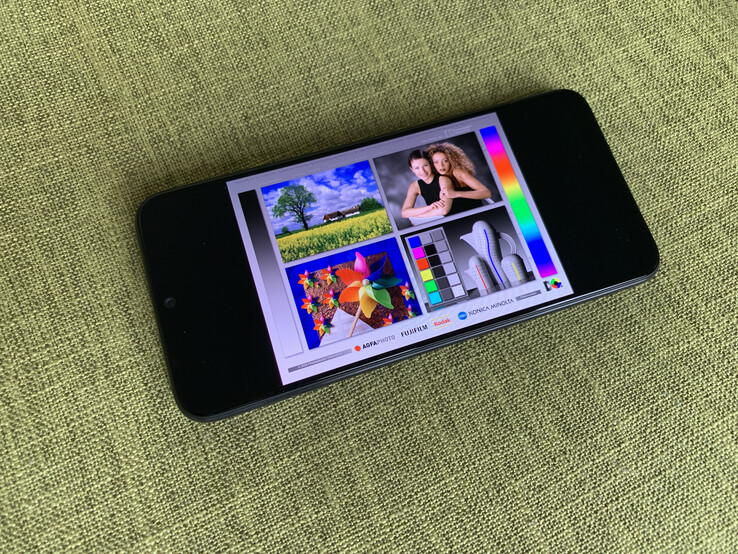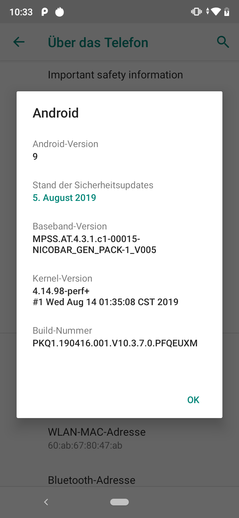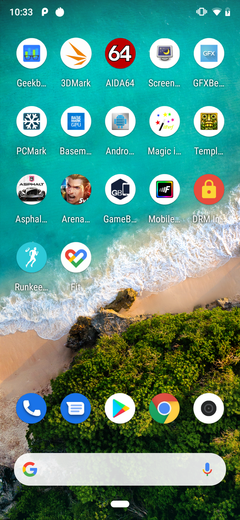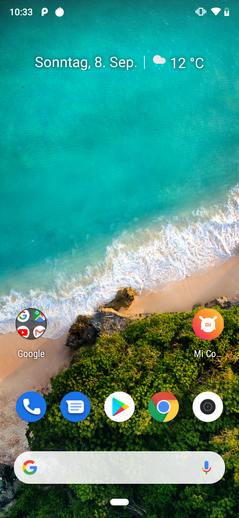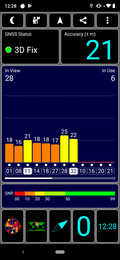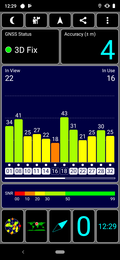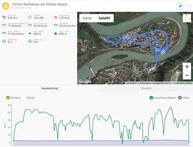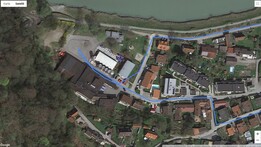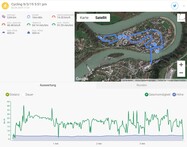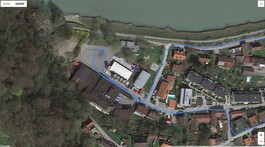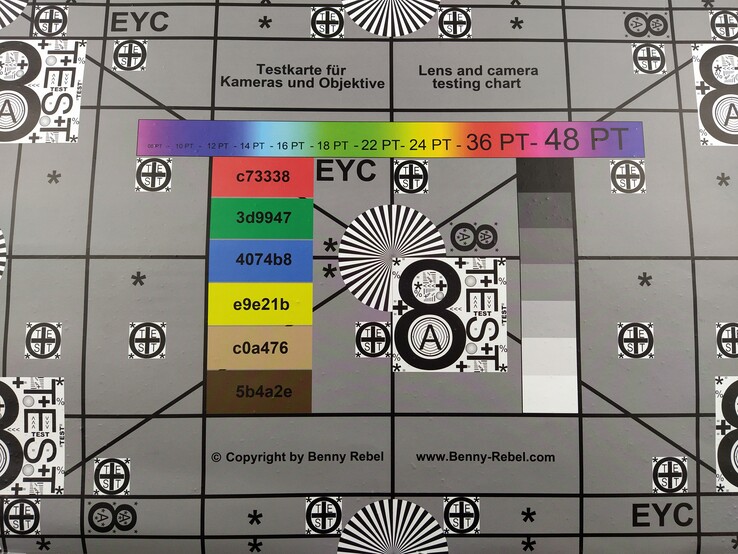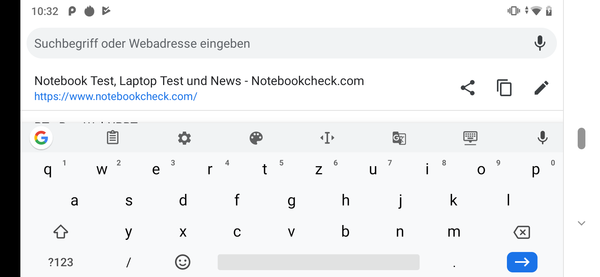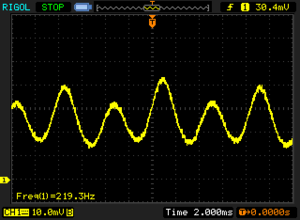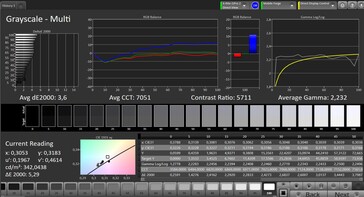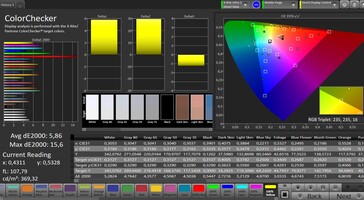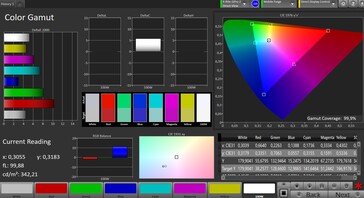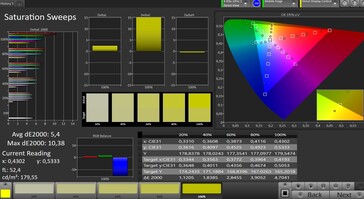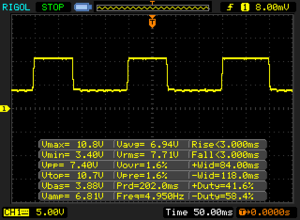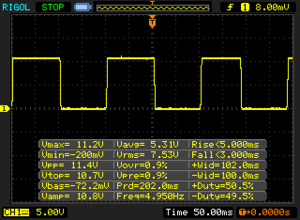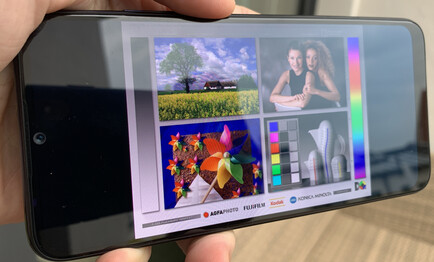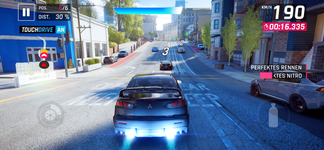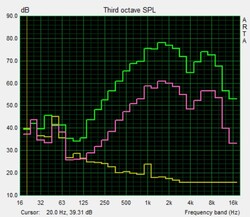Xiaomi Mi A3 Smartphone Review – The price-performance king again!
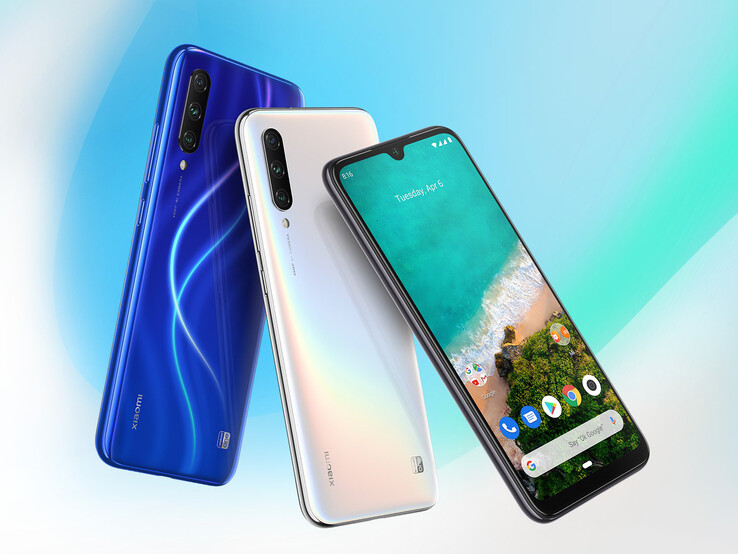
We were excited by last year's Xiaomi Mi A2: The smartphone offered a high-quality aluminum case and a lot of performance for only slightly more than 200 Euros (~$221). This test will show whether the successor can also bring the same excitement.
Surely the Xiaomi Mi A3 does many things differently than the predecessor? Instead of aluminum, there is now glass in both the front and back, which increases the signal strength. At the same time, the fingerprint sensor has wandered below the display and the fairly thick bezels have transformed into a small waterdrop notch. A larger battery is also part of the changes, along with a lower-resolution display.
So it will be interesting to see how the Xiaomi smartphone fares in our test. As comparison devices, we include the Honor 20 Lite, the Motorola Moto G7, the Huawei P Smart Plus 2019, and the Nokia 4.2. For your own comparison, you can also add more devices underneath each of the comparison charts.
Case – A modern design for the Mi A3
As already mentioned, this time the case is made from trendy glass with a metal frame. As color options, blue, pearl white, and dark gray are available. In front are small bezels and a waterdrop notch that holds the front camera. At 84%, the screen-to-body ratio is good. There is still some space above the display for a small notification LED and the ear piece, and there is a slightly wider chin below the display.
In all the color variants, the back reflects the light. This effect is the most spectacular in the white color version, and it is slightly more subdued with the other colors. The impression of the quality is solid, and the workmanship of the material transitions is clean. The smartphone is able to resist pressure well and can hardly be warped, and then it only produces some very quiet creaking at most.
Equipment – microSD and a 3.5-mm audio port
In terms of storage equipment, the Xiaomi Mi A3 chooses a path in the middle: Compared to the predecessor, the RAM was reduced to 4 GB and the storage of 64 GB was kept, which corresponds to the class standard. At this point, the Honor 20 Lite costs hardly any more than the Mi A3 and offers twice the amount of data storage.
You can either insert two SIM cards into the smartphone or one SIM card and a microSD, allowing you to expand the storage. However, you cannot use any cards that are formatted as exFAT, since the system does not recognize them. You also cannot move apps onto the storage cards.
Thanks to the 3.5-mm audio port, friends of analog sound output can look forward to the Mi A3. While the USB-C port looks modern, it only supports USB-2.0 speed. On the other hand, there is an infrared blaster on the top edge, which you can use to control your TV, for example. With Bluetooth 5.0, a current version of this standard is included.
The Mi A3 also offers FM radio and a notification LED above the display.
Software – Android One and HD streaming
Xiaomi does not use MIUI in the Mi A3 but opts for pure Android, like in the predecessor. The smartphone is even part of the Android-One program, which guarantees software updates for the next few years. Android 9 is preinstalled, and at the time of our testing, the security patches are on the level of August 2019 and thus current.
Besides the Mi Community app and the Mi Store app, Xiaomi did not install any additional apps, which should please the purists. On the other hand, you also have to make do without some features compared to MIUI, such as the Game Speed Booster or Dark Mode, which is finally supposed to also come to vanilla Android in Android 10.
The Xiaomi Mi A3 possesses DRM-L1 certification, so it is able to reproduce HD content from streaming platforms.
Communication and GPS – The Mi A3 has some WLAN problems
The Xiaomi Mi A3 supports Wi-Fi 5, which means that you have to make do without the more current and faster 802.11ax standard. But this is normal in this price range and even above. The Honor 20 Lite, which was originally more expensive, only offers Wi-Fi 4. So these are good prerequisites for the Mi A3, and it uses them well in terms of speed: The smartphone reaches up to 280 Mb/s when transferring data in the test with our Linksys EA8500 reference router. However, the transfer speeds vary strongly, so that we only get values between 158 and 172 Mb/s on average. The WLAN signal is not as stable as we would have hoped for. This problem is also mentioned on the Internet, where people recommend switching from WPA2 to the less secure WPA encryption method.
As in the predecessor, the Mi A3 also supports 10 LTE frequencies that are sufficient for central Europe and other European countries. However, the European model lacks some frequencies that are necessary in the USA, so depending on your location and the provider, you could encounter some difficulties with your reception there. Within the city and its surroundings, the reception is also decent indoors, but it is noticeably better outdoors.
| Networking | |
| iperf3 transmit AX12 | |
| Xiaomi Mi 6X | |
| Huawei P Smart Plus 2019 | |
| Xiaomi Mi A3 | |
| Motorola Moto G7 | |
| Honor 20 Lite | |
| Nokia 4.2 | |
| iperf3 receive AX12 | |
| Xiaomi Mi 6X | |
| Huawei P Smart Plus 2019 | |
| Xiaomi Mi A3 | |
| Motorola Moto G7 | |
| Honor 20 Lite | |
| Nokia 4.2 | |
The Mi A3 supports A-GPS, GLONASS and BeiDou for navigation. Indoors, it takes quite a long time until we can finally get a GPS signal near the window, where the device can determine our location with an accuracy of up to 21 meters. Outdoors, the accuracy of the locating quickly increases up to four meters. In Google Maps, the smartphone is also able to locate us with reasonable accuracy. The compass also works well, showing our viewing direction fairly accurately.
For our practical test, we are also taking the Garmin Edge 520 professional navigation device for bikes with us for comparison. The Xiaomi Mi A3 does not fare badly here. While it cuts some corners from time to time, most of the time it handles even the narrow roads in the old city fairly accurately. There are some small deviations, but those who don't depend on absolute precision for every second of their trip will be served well by the Xiaomi Mi A3 in everyday navigation.
Phone Functions and Voice Quality – Hollow, but understandable
Following the purist paradigm of Android One, the standard app from Google is used as the Telephone app. It is clearly arranged and offers the option to view favorites when opening the app. In addition, this area also shows frequently contacted numbers automatically. Tabs allow you to access the recent calls or contacts lists.
VoLTE and VoWiFi work on the device.
The voice quality is acceptable. While your conversation partner can be understood easily, the voice is not completely clear and also slightly distorted at high volumes. Our voice is also transferred not completely clearly but is still understandable. Using the speaker and hands-free microphone, we can also hear our conversation partner well, but the voice is not as present as when using a really good telephone, and our voice is transferred sounding slightly hollow here.
Note: When we try to make another call using Skype, the drop-outs in the WLAN become noticeable. Again and again, the voice of our conversation partner is interrupted or our own voice isn't transferred to the conversation partner. Xiaomi should deliver an update patch for this quickly. We did not have any trouble making regular phone calls using the mobile network.
Cameras – A 48-MP main camera with good quality
There are quite significant changes in the cameras. While it had been two lenses in the back of the predecessor, there are now three, with the third lens not taking separate recordings but offering additional information on the depth sharpness. With 48 megapixels, the main camera has a fairly high resolution. However, four pixels are combined into one by default, in order to increase the captured brightness. This results in 12-megapixel recordings, which is completely sufficient for everyday pictures in most cases. But if you need them, you can also record 48-megapixel images.
An additional wide-angle lens offers a larger viewing angle and smooth zooming up to the 0.6 factor. There is also a digital zoom that offers up to eight times the enlargement compared to the standard lens. Generally, the main camera takes fairly good pictures that are rich in detail. The white balance tends strongly towards blue. The brightness could be better, for example in the scene of the surroundings. The same problem can be seen when looking at the low-light recording: You can hardly recognize any detail in the teddy bear or the figure on the right. So the camera is rather badly equipped for dark situations.
With the video function, you can record movies with a resolution of up to 4K and at 30 FPS. Darker areas can quickly result in some visible graininess, and the adjustment of the exposure is not smooth but occurs in some slight steps. However, the color reproduction and sharpness are okay here, so that you can record your own videos with the MI A3. The sound recording also works without any problems.
At 32 megapixels, the resolution of the front camera is ample, but the brightness could also be better here. If you slightly enlarge the picture, you can see some clear graininess, and the sharpness is rather mediocre in the detail. For snapshots and the occasional selfies, the camera is sufficient, but it does not come near the quality of a really good front camera.
By the way, the camera app really comes from Xiaomi, so the manufacturer slightly deviates from pure Android here. It is easy to operate and the necessary adjustments are presented fairly clearly. Those who do not like the app can install numerous camera apps from the Google Store.
We also evaluate the camera in controlled light conditions in our test lab. At 1 Lux, the test chart can hardly be recognized and the ColorChecker cannot really be recognized at all anymore. On the other hand, with perfect lighting, we see a quite decent result in terms of the color accuracy. Particularly yellow and black tones are reproduced quite accurately, but dark color tones create more problems.
Under bright light, the reproduction of the test chart is very sharp and without any visible artifacts in the color areas.
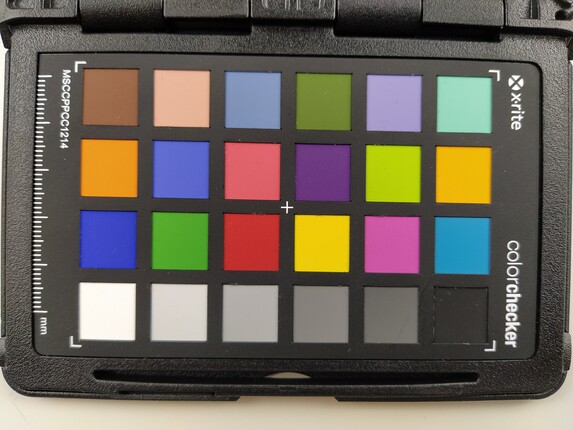
Accessories and Warranty – Bumper case included
In addition to the regular accessories, Xiaomi also adds a silicone bumper case into the box, so that you don't have to buy this separately anymore. Since it is a clear case, you can still see the color reflections in the back of the smartphone.
Officially, Xiaomi still does not offer warranty processing for its customers in all countries. However, you can get a warranty from the vendor (24 months according to warranty laws in Germany, for example).
Input Devices and Operation – A decent in-screen fingerprint sensor
The standard keyboard included with Android is called Google G Board, and it is also used on the Xiaomi Mi A3. It is easy to operate, offers many setting adjustments, and it can also be displayed with various designs. From time to time, we had some problems with inputs on the right edge of the display not being recognized immediately, but otherwise you can type easily and reliably on the Mi A3. Overall, the touchscreen responds reliably to our gestures and can be operated without any problems.
The fingerprint sensor is below the glass of the display. When you pick up the smartphone, the position of the sensor is displayed in standby. Since the sensor is positioned fairly close to the bottom edge of the display, we had to shift our thumb slightly when picking up the smartphone. Samsung has found a more intuitive position in the Galaxy Note 10, for example. The sensor works fairly reliably, but sometimes the fingerprint is not recognized the first time. It also takes a moment longer until the smartphone is unlocked than with a good, dedicated sensor in the case or the very good in-screen sensor of the Galaxy Note10.
You can also unlock it via face recognition, but this only uses the standard method of a picture comparison. Although the software has improved here in the last few months, refusing to unlock the smartphone when we use a picture or mask of the owner, some risk still remains. In addition, face recognition is only activated after you have turned on the smartphone, while you can use the fingerprint sensor directly from standby.
Display – A dark OLED in the Mi A3
In contrast to the Mi A2, this time an AMOLED display is used. However, it offers a lower display resolution of 1560x720 pixels and also a lower brightness than the predecessor. We measure 355 cd/m² on average, which is almost 100 cd/m² lower than in all the other comparison devices. When using the brightness sensor, the brightness is also not increased above this level. The brightness distribution is fairly even at 91%.
| |||||||||||||||||||||||||
Brightness Distribution: 91 %
Center on Battery: 348 cd/m²
Contrast: ∞:1 (Black: 0 cd/m²)
ΔE ColorChecker Calman: 5.86 | ∀{0.5-29.43 Ø4.77}
ΔE Greyscale Calman: 3.6 | ∀{0.09-98 Ø5}
99.9% sRGB (Calman 2D)
Gamma: 2.232
CCT: 7051 K
| Xiaomi Mi A3 AMOLED, 1560x720, 6.1" | Honor 20 Lite IPS, 2340x1080, 6.2" | Motorola Moto G7 IPS, 2270x1080, 6.2" | Huawei P Smart Plus 2019 IPS, 2340x1080, 6.2" | Xiaomi Mi 6X LCD IPS, 2160x1080, 6" | Nokia 4.2 IPS, 1520x720, 5.7" | |
|---|---|---|---|---|---|---|
| Screen | 15% | 14% | 34% | -3% | -1% | |
| Brightness middle (cd/m²) | 348 | 455 31% | 471 35% | 427 23% | 459 32% | 445 28% |
| Brightness (cd/m²) | 355 | 456 28% | 453 28% | 415 17% | 441 24% | 424 19% |
| Brightness Distribution (%) | 91 | 94 3% | 94 3% | 84 -8% | 91 0% | 91 0% |
| Black Level * (cd/m²) | 0.58 | 0.5 | 0.2 | 0.47 | 0.26 | |
| Colorchecker dE 2000 * | 5.86 | 4.43 24% | 5.5 6% | 1.95 67% | 5.8 1% | 5.9 -1% |
| Colorchecker dE 2000 max. * | 15.6 | 6.81 56% | 7.95 49% | 4.47 71% | 10.7 31% | 9.3 40% |
| Greyscale dE 2000 * | 3.6 | 5.4 -50% | 5 -39% | 2.3 36% | 7.3 -103% | 6.8 -89% |
| Gamma | 2.232 99% | 2.248 98% | 2.326 95% | 2.07 106% | 2.28 96% | 2.2 100% |
| CCT | 7051 92% | 7336 89% | 7654 85% | 6414 101% | 7984 81% | 8443 77% |
| Contrast (:1) | 784 | 942 | 2135 | 977 | 1712 |
* ... smaller is better
Screen Flickering / PWM (Pulse-Width Modulation)
| Screen flickering / PWM detected | 219 Hz | ||
The display backlight flickers at 219 Hz (worst case, e.g., utilizing PWM) . The frequency of 219 Hz is relatively low, so sensitive users will likely notice flickering and experience eyestrain at the stated brightness setting and below. In comparison: 53 % of all tested devices do not use PWM to dim the display. If PWM was detected, an average of 8081 (minimum: 5 - maximum: 343500) Hz was measured. | |||
The perfect black of the OLED display results in an unlimited amount of contrast in the Mi A3 by theory. Unfortunately, something else is also typical for OLED displays: Since there is no background illumination that could be dimmed here, the manufacturers use pulse width modulation, which is a quick turning on and off, to make the display appear darker. At 219 Hz, the frequency is typical for OLED displays, so sensitive people should take a look at the display before buying it. The fairly low response times of the display should be interesting for gamers.
A slight blue tint is noticeable in the grayscale, and in terms of the color accuracy, it is mainly red colors that deviate. According to our measurements with CalMAN, the sRGB color space is almost completely covered. While these measurements are more of an indication, for a 200-Euro device (~$221), they are quite impressive.
Display Response Times
| ↔ Response Time Black to White | ||
|---|---|---|
| 6 ms ... rise ↗ and fall ↘ combined | ↗ 3 ms rise | |
| ↘ 3 ms fall | ||
| The screen shows very fast response rates in our tests and should be very well suited for fast-paced gaming. In comparison, all tested devices range from 0.1 (minimum) to 240 (maximum) ms. » 17 % of all devices are better. This means that the measured response time is better than the average of all tested devices (20.2 ms). | ||
| ↔ Response Time 50% Grey to 80% Grey | ||
| 8 ms ... rise ↗ and fall ↘ combined | ↗ 5 ms rise | |
| ↘ 3 ms fall | ||
| The screen shows fast response rates in our tests and should be suited for gaming. In comparison, all tested devices range from 0.165 (minimum) to 636 (maximum) ms. » 19 % of all devices are better. This means that the measured response time is better than the average of all tested devices (31.6 ms). | ||
As in most other OLED displays, there are no problems with steep viewing angles. When looking from the sides, for example, there are no noticeable color distortions and no loss in brightness.
Outdoors, using the Mi A3 is only comfortable in shady areas or on cloudy days. While the high contrast helps, it cannot make up for the lack of display brightness.
Performance – The processor is hardly any faster
The fairly new Qualcomm Snapdragon 665 is really meant for more-expensive devices, but Xiaomi has created a reputation of offering a lot of performance for the money. So the fairly powerful SoC with eight cores does well, and in many benchmarks it is even slightly faster than the Honor 20 Lite, which was originally much more expensive. The Motorola Moto G7 and the Nokia 4.2 are left even further behind. However, compared to the Mi A2, the difference is not really large. One reason for this might be the fact that compared to the Snapdragon 660 in the Mi A2, not much has changed in the successor SoC.
In the graphics benchmarks, the Mi A3 even falls behind its predecessor, and the Adreno 512 in the Mi A2 probably offers minimally more power overall.
| PCMark for Android | |
| Work performance score (sort by value) | |
| Xiaomi Mi A3 | |
| Honor 20 Lite | |
| Motorola Moto G7 | |
| Huawei P Smart Plus 2019 | |
| Xiaomi Mi 6X | |
| Nokia 4.2 | |
| Average Qualcomm Snapdragon 665 (7437 - 9051, n=10) | |
| Work 2.0 performance score (sort by value) | |
| Xiaomi Mi A3 | |
| Honor 20 Lite | |
| Motorola Moto G7 | |
| Huawei P Smart Plus 2019 | |
| Xiaomi Mi 6X | |
| Nokia 4.2 | |
| Average Qualcomm Snapdragon 665 (6189 - 11432, n=12) | |
| Basemark GPU 1.1 | |
| 1920x1080 Vulkan Medium Offscreen (sort by value) | |
| Nokia 4.2 | |
| Average Qualcomm Snapdragon 665 (n=1) | |
| Vulkan Medium Native (sort by value) | |
| Xiaomi Mi A3 | |
| Xiaomi Mi 6X | |
| Nokia 4.2 | |
| Average Qualcomm Snapdragon 665 (6.65 - 10.7, n=2) | |
| 1920x1080 OpenGL Medium Offscreen (sort by value) | |
| Xiaomi Mi A3 | |
| Xiaomi Mi 6X | |
| Nokia 4.2 | |
| Average Qualcomm Snapdragon 665 (8.24 - 12, n=2) | |
| AnTuTu v7 - Total Score (sort by value) | |
| Xiaomi Mi A3 | |
| Honor 20 Lite | |
| Motorola Moto G7 | |
| Huawei P Smart Plus 2019 | |
| Xiaomi Mi 6X | |
| Nokia 4.2 | |
| Average Qualcomm Snapdragon 665 (n=1) | |
| VRMark - Amber Room (sort by value) | |
| Xiaomi Mi A3 | |
| Xiaomi Mi 6X | |
| Nokia 4.2 | |
| Average Qualcomm Snapdragon 665 (1092 - 1134, n=2) | |
In the browser benchmarks as well, the Mi A3 cannot quite reach the performance values of the predecessor. While the difference is not that large and should be hardly noticeable in practice, those who expected even faster surfing in the successor will be disappointed.
Subjectively, websites are loaded quite fast and images also become available quickly.
| Jetstream 2 - 2.0 Total Score | |
| Average of class Smartphone (23.8 - 387, n=147, last 2 years) | |
| Xiaomi Mi A3 (Chrome 76) | |
| Huawei P Smart Plus 2019 (Chrome 74) | |
| Honor 20 Lite (Chrome 75) | |
| Average Qualcomm Snapdragon 665 (22.9 - 31.2, n=6) | |
| Nokia 4.2 (Chrome 74) | |
| Speedometer 2.0 - Result 2.0 | |
| Average of class Smartphone (15.2 - 643, n=119, last 2 years) | |
| Honor 20 Lite (Chrome 75) | |
| Huawei P Smart Plus 2019 (Chome 74) | |
| Xiaomi Mi A3 (Chome 76) | |
| Average Qualcomm Snapdragon 665 (25.4 - 30.8, n=6) | |
| Nokia 4.2 (Chrome 74) | |
| WebXPRT 3 - Overall | |
| Average of class Smartphone (38 - 380, n=30, last 2 years) | |
| Huawei P Smart Plus 2019 (Chrome 74) | |
| Honor 20 Lite (Chrome 75) | |
| Xiaomi Mi 6X (Chrome 67) | |
| Motorola Moto G7 (Chrome 71) | |
| Xiaomi Mi A3 (Chrome 76) | |
| Average Qualcomm Snapdragon 665 (38 - 58, n=9) | |
| Nokia 4.2 (Chrome 74) | |
| Octane V2 - Total Score | |
| Average of class Smartphone (2228 - 126661, n=194, last 2 years) | |
| Xiaomi Mi 6X (Chrome 67) | |
| Huawei P Smart Plus 2019 (Chrome 74) | |
| Honor 20 Lite (Chrome 75) | |
| Xiaomi Mi A3 (Chrome 76) | |
| Average Qualcomm Snapdragon 665 (6133 - 9671, n=9) | |
| Motorola Moto G7 (Chrome 71) | |
| Nokia 4.2 (Chrome 74) | |
| Mozilla Kraken 1.1 - Total | |
| Nokia 4.2 (Chrome 74) | |
| Motorola Moto G7 (Chrome 71) | |
| Honor 20 Lite (Chrome 75) | |
| Average Qualcomm Snapdragon 665 (4434 - 6719, n=9) | |
| Xiaomi Mi 6X (Chrome 67) | |
| Xiaomi Mi A3 (Chrome 76) | |
| Huawei P Smart Plus 2019 (Chrome 74) | |
| Average of class Smartphone (257 - 28190, n=154, last 2 years) | |
* ... smaller is better
An advantage compared to the Mi A2 is that the Mi A3 supports microSD cards. The speed of the reader is okay using our reference microSD card, but other smartphones achieve even higher access rates.
On the other hand, Xiaomi again sets an example with the internal storage: We would not expect UFS-2.1 storage in this price range, and we are not getting it in the comparison devices either. In this way, our test unit is able to achieve a speed advantage in most of the tests, which is reflected in shorter load times and faster data transfers in practice.
| Xiaomi Mi A3 | Honor 20 Lite | Motorola Moto G7 | Huawei P Smart Plus 2019 | Xiaomi Mi 6X | Nokia 4.2 | Average 64 GB UFS 2.1 Flash | Average of class Smartphone | |
|---|---|---|---|---|---|---|---|---|
| AndroBench 3-5 | -16% | -7% | -19% | -43% | -45% | 8% | 397% | |
| Sequential Read 256KB (MB/s) | 502 | 288.1 -43% | 297 -41% | 295.4 -41% | 272 -46% | 220.4 -56% | 696 ? 39% | 2235 ? 345% |
| Sequential Write 256KB (MB/s) | 184 | 200.9 9% | 216 17% | 152.8 -17% | 203.7 11% | 18.17 -90% | 224 ? 22% | 1871 ? 917% |
| Random Read 4KB (MB/s) | 126.9 | 38.7 -70% | 69.3 -45% | 40.3 -68% | 73 -42% | 17.51 -86% | 137.2 ? 8% | 297 ? 134% |
| Random Write 4KB (MB/s) | 117.4 | 73.1 -38% | 75.6 -36% | 77.3 -34% | 6.89 -94% | 4.31 -96% | 84.7 ? -28% | 343 ? 192% |
| Sequential Read 256KB SDCard (MB/s) | 67.8 ? | 75.7 ? 12% | 86.9 ? 28% | 76.3 ? 13% | 86.7 ? 28% | 68.6 ? 1% | ||
| Sequential Write 256KB SDCard (MB/s) | 50.1 ? | 66.9 ? 34% | 66.8 ? 33% | 66.7 ? 33% | 65.9 ? 32% | 52.2 ? 4% |
Gaming – Only for medium demands
Gaming at 60 Hz is possible with the Xiaomi Mi A3, but of course the game has to support the higher frame rate. This is the case for Arena of Valor, and a fairly stable 60 FPS is achieved, but interestingly, the higher graphics settings are more stable here than the low ones.
Asphalt 9 is generally more demanding and is hardly able to run at a smooth 30 FPS on the smartphone. In order to be able to play fairly smoothly, you should at least select the lowest settings.
With Temple Run 2, we also test the control via position sensor and touchscreen. Both work without any problems in the Mi A3 and the game can be controlled reliably using these options.
Emissions – Hardly any warming
Temperature
Under full load, some significant warming can be felt in the top area of the smartphone. However, this is not critical and can at most become uncomfortable in your pants pocket in summer. The warming decreases considerably towards the bottom of the phone. In idle operation, there is no noticeable warming in the hand.
In our performance endurance test using the GFXBench battery test, we determine that the smartphone only throttles minimally even after numerous runs of a demanding benchmark. So there should not be any reductions in performance.
(±) The maximum temperature on the upper side is 43 °C / 109 F, compared to the average of 35.2 °C / 95 F, ranging from 21.9 to 247 °C for the class Smartphone.
(±) The bottom heats up to a maximum of 42.6 °C / 109 F, compared to the average of 34 °C / 93 F
(+) In idle usage, the average temperature for the upper side is 30.6 °C / 87 F, compared to the device average of 32.9 °C / 91 F.
Speaker
The speaker of the Mi A3 is positioned at the bottom of the case. In terms of its volume, it is minimally louder than its predecessor and also offers slightly lower frequencies. For a 200-Euro smartphone (~$221), the sound is absolutely convincing. It neither emphasizes the highs too much, nor does it get boomy. The opposite is the case: The sound is quite clear and balanced, and there are no distortions even at maximum volume.
A positive for audio port enthusiasts is that the 3.5-mm port is present again, after it had been cut in the Mi A2. According to the manufacturer, this is a reaction to user complaints. The audio signals are transferred clearly through the port, as well as when using Bluetooth 5.0, which even supports aptX HD.
Xiaomi Mi A3 audio analysis
(+) | speakers can play relatively loud (85.7 dB)
Bass 100 - 315 Hz
(-) | nearly no bass - on average 74.1% lower than median
(+) | bass is linear (0% delta to prev. frequency)
Mids 400 - 2000 Hz
(-) | nearly no mids - on average 74.1% lower than median
(+) | mids are linear (0% delta to prev. frequency)
Highs 2 - 16 kHz
(-) | nearly no highs - on average 74.1% lower than median
(+) | highs are linear (0% delta to prev. frequency)
Overall 100 - 16.000 Hz
(-) | overall sound is not linear (126% difference to median)
Compared to same class
» 96% of all tested devices in this class were better, 3% similar, 1% worse
» The best had a delta of 11%, average was 35%, worst was 134%
Compared to all devices tested
» 99% of all tested devices were better, 1% similar, 0% worse
» The best had a delta of 4%, average was 24%, worst was 134%
Xiaomi Mi 6X audio analysis
(+) | speakers can play relatively loud (84.1 dB)
Bass 100 - 315 Hz
(-) | nearly no bass - on average 27.6% lower than median
(±) | linearity of bass is average (9.7% delta to prev. frequency)
Mids 400 - 2000 Hz
(+) | balanced mids - only 3.3% away from median
(+) | mids are linear (5.3% delta to prev. frequency)
Highs 2 - 16 kHz
(+) | balanced highs - only 2.7% away from median
(+) | highs are linear (4% delta to prev. frequency)
Overall 100 - 16.000 Hz
(±) | linearity of overall sound is average (19.1% difference to median)
Compared to same class
» 24% of all tested devices in this class were better, 9% similar, 67% worse
» The best had a delta of 11%, average was 35%, worst was 134%
Compared to all devices tested
» 45% of all tested devices were better, 7% similar, 48% worse
» The best had a delta of 4%, average was 24%, worst was 134%
Battery Life – The Mi A3 runs forever
Power Consumption
Compared to the predecessor, the power consumption has increased slightly, and most of the comparison devices consume at least slightly less power. Particularly during idle operation, the Mi A3 can use more power at times.
| Off / Standby | |
| Idle | |
| Load |
|
Key:
min: | |
| Xiaomi Mi A3 4030 mAh | Honor 20 Lite 3400 mAh | Motorola Moto G7 3000 mAh | Huawei P Smart Plus 2019 3400 mAh | Xiaomi Mi 6X 3010 mAh | Nokia 4.2 3000 mAh | Average Qualcomm Snapdragon 665 | Average of class Smartphone | |
|---|---|---|---|---|---|---|---|---|
| Power Consumption | -5% | 1% | 13% | 14% | 23% | 6% | -9% | |
| Idle Minimum * (Watt) | 0.8 | 0.9 -13% | 1.1 -38% | 0.8 -0% | 0.65 19% | 0.74 7% | 1.017 ? -27% | 0.847 ? -6% |
| Idle Average * (Watt) | 2 | 1.6 20% | 1.8 10% | 1.2 40% | 1.94 3% | 1.9 5% | 1.893 ? 5% | 1.446 ? 28% |
| Idle Maximum * (Watt) | 3.3 | 2.2 33% | 2.6 21% | 2.3 30% | 1.97 40% | 2.21 33% | 2.36 ? 28% | 1.63 ? 51% |
| Load Average * (Watt) | 4.1 | 6 -46% | 4.2 -2% | 4.5 -10% | 4.65 -13% | 3.04 26% | 3.77 ? 8% | 6.95 ? -70% |
| Load Maximum * (Watt) | 7.7 | 9.1 -18% | 6.8 12% | 7.3 5% | 5.93 23% | 4.15 46% | 6.66 ? 14% | 11.3 ? -47% |
* ... smaller is better
Battery Life
However, the higher power consumption of the Xiaomi Mi A3 hardly makes any difference, since Xiaomi has significantly increased the size of the battery. The capacity is about 30% larger than that of the predecessor and also considerably more than in all the comparison devices. It is not surprising that our test unit lasts the longest by far, with 16:25 hours in our WLAN test. While the advantage is slightly smaller during idle operation, the battery life of the Mi A3 turns out very good, overall.
Thanks to the quick-charge function using up to 18 watts, it takes less than 2 hours to completely recharge the battery.
| Xiaomi Mi A3 4030 mAh | Honor 20 Lite 3400 mAh | Motorola Moto G7 3000 mAh | Huawei P Smart Plus 2019 3400 mAh | Xiaomi Mi 6X 3010 mAh | Nokia 4.2 3000 mAh | |
|---|---|---|---|---|---|---|
| Battery runtime | -30% | -19% | -33% | -41% | -29% | |
| Reader / Idle (h) | 28.7 | 25.8 -10% | 22.4 -22% | 17.4 -39% | ||
| H.264 (h) | 17.1 | 13.7 -20% | 8.9 -48% | 10.1 -41% | ||
| WiFi v1.3 (h) | 16.4 | 11.4 -30% | 13.3 -19% | 8.7 -47% | 8.3 -49% | 11.6 -29% |
| Load (h) | 5 | 3.7 -26% | 4.2 -16% | 3.2 -36% |
Pros
Cons
Verdict – Mostly more, but sometimes less
The question we asked at the very beginning of our test is not so easy to answer: Compared to its predecessor, was the Mi A3 slimmed-down or improved? There are signs of both. There are factors like the lower display resolution, the slightly decreased 3D performance, and the higher power consumption. On the other hand, there are the more modern design, the significantly longer battery life, the better camera equipment, and a speaker that was again improved.
The Mi A3 also suffers from stuttering WLAN, which Xiaomi must quickly fix with an update, since otherwise the smartphone is almost unusable in WLAN for communication apps such as Skype.
In some areas, the Xiaomi Mi A3 is better than its predecessor. But Xiaomi should quickly fix the stuttering WLAN with an update.
The competitors have to make a continued effort, since for 200 Euros (~$221; ~$185 in the USA), currently almost no-one else offers as much computing power, an OLED display, battery life that lasts forever, and even a modern design. So in the end, the positive aspects count more for us, even if the Mi A2 still offers the better price-performance ratio compared to its successor for currently 50 Euros less (~$55).
Note: The Xiaomi Mi A3 is one of the first smartphones that we evaluated using the new Version 7 of our rating system. Since some criteria became stricter here and some value limits were shifted so that future devices won't blow the scale, the rating according to Version 7 is lower than that of earlier tests. In the next few weeks, we will bring the most important devices into the new version of our rating system, so that you can continue to easily compare them.
Xiaomi Mi A3
- 09/03/2022 v7 (old)
Florian Schmitt


